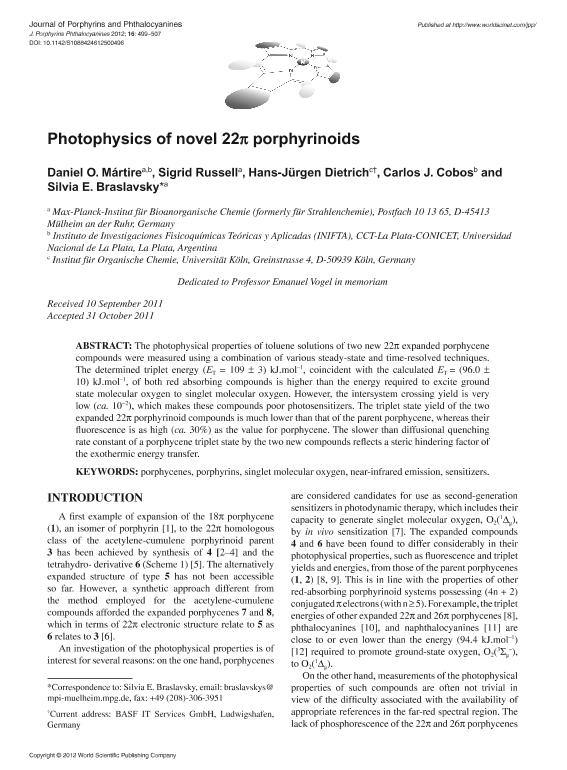Mostrar el registro sencillo del ítem
dc.contributor.author
Martire, Daniel Osvaldo

dc.contributor.author
Russell, Sigrid
dc.contributor.author
Dietrich, Hans Jürgen
dc.contributor.author
Cobos, Carlos Jorge

dc.contributor.author
Braslavsky, Silvia E.
dc.date.available
2019-09-25T16:34:06Z
dc.date.issued
2012-01
dc.identifier.citation
Martire, Daniel Osvaldo; Russell, Sigrid; Dietrich, Hans Jürgen; Cobos, Carlos Jorge; Braslavsky, Silvia E.; Photophysics of novel 22 pi porphyrinoids.; World Sci Publ Co Inc; Journal Of Porphyrins And Phthalocyanines; 16; 1-2012; 499-507
dc.identifier.issn
1088-4246
dc.identifier.uri
http://hdl.handle.net/11336/84410
dc.description.abstract
The photophysical properties of toluene solutions of two new 22! expanded porphycene compounds were measured using a combination of various steady-state and time-resolved techniques. The determined triplet energy (ET = 109 ± 3) kJ.mol–1, coincident with the calculated ET = (96.0 ±! expanded porphycene compounds were measured using a combination of various steady-state and time-resolved techniques. The determined triplet energy (ET = 109 ± 3) kJ.mol–1, coincident with the calculated ET = (96.0 ±ET = 109 ± 3) kJ.mol–1, coincident with the calculated ET = (96.0 ± 10) kJ.mol–1, of both red absorbing compounds is higher than the energy required to excite ground state molecular oxygen to singlet molecular oxygen. However, the intersystem crossing yield is very low (ca. 10−2), which makes these compounds poor photosensitizers. The triplet state yield of the two expanded 22! porphyrinoid compounds is much lower than that of the parent porphycene, whereas their fluorescence is as high (ca. 30%) as the value for porphycene. The slower than diffusional quenching rate constant of a porphycene triplet state by the two new compounds reflects a steric hindering factor of the exothermic energy transfer.–1, of both red absorbing compounds is higher than the energy required to excite ground state molecular oxygen to singlet molecular oxygen. However, the intersystem crossing yield is very low (ca. 10−2), which makes these compounds poor photosensitizers. The triplet state yield of the two expanded 22! porphyrinoid compounds is much lower than that of the parent porphycene, whereas their fluorescence is as high (ca. 30%) as the value for porphycene. The slower than diffusional quenching rate constant of a porphycene triplet state by the two new compounds reflects a steric hindering factor of the exothermic energy transfer.ca. 10−2), which makes these compounds poor photosensitizers. The triplet state yield of the two expanded 22! porphyrinoid compounds is much lower than that of the parent porphycene, whereas their fluorescence is as high (ca. 30%) as the value for porphycene. The slower than diffusional quenching rate constant of a porphycene triplet state by the two new compounds reflects a steric hindering factor of the exothermic energy transfer.! porphyrinoid compounds is much lower than that of the parent porphycene, whereas their fluorescence is as high (ca. 30%) as the value for porphycene. The slower than diffusional quenching rate constant of a porphycene triplet state by the two new compounds reflects a steric hindering factor of the exothermic energy transfer.ca. 30%) as the value for porphycene. The slower than diffusional quenching rate constant of a porphycene triplet state by the two new compounds reflects a steric hindering factor of the exothermic energy transfer.
dc.format
application/pdf
dc.language.iso
eng
dc.publisher
World Sci Publ Co Inc

dc.rights
info:eu-repo/semantics/openAccess
dc.rights.uri
https://creativecommons.org/licenses/by-nc-sa/2.5/ar/
dc.subject
Porphycenes
dc.subject
Porphyrins
dc.subject
Singlet Molecular Oxygen
dc.subject
Near-Infrared Emission
dc.subject.classification
Físico-Química, Ciencia de los Polímeros, Electroquímica

dc.subject.classification
Ciencias Químicas

dc.subject.classification
CIENCIAS NATURALES Y EXACTAS

dc.title
Photophysics of novel 22 pi porphyrinoids.
dc.type
info:eu-repo/semantics/article
dc.type
info:ar-repo/semantics/artículo
dc.type
info:eu-repo/semantics/publishedVersion
dc.date.updated
2019-05-08T17:21:05Z
dc.journal.volume
16
dc.journal.pagination
499-507
dc.journal.pais
Estados Unidos

dc.description.fil
Fil: Martire, Daniel Osvaldo. Consejo Nacional de Investigaciones Científicas y Técnicas. Centro Científico Tecnológico Conicet - La Plata. Instituto de Investigaciones Fisicoquímicas Teóricas y Aplicadas. Universidad Nacional de La Plata. Facultad de Ciencias Exactas. Instituto de Investigaciones Fisicoquímicas Teóricas y Aplicadas; Argentina
dc.description.fil
Fil: Russell, Sigrid. Institut Max Planck fuer Bioanorganische Chemie; Alemania
dc.description.fil
Fil: Dietrich, Hans Jürgen. Universitat zu Köln; Alemania
dc.description.fil
Fil: Cobos, Carlos Jorge. Consejo Nacional de Investigaciones Científicas y Técnicas. Centro Científico Tecnológico Conicet - La Plata. Instituto de Investigaciones Fisicoquímicas Teóricas y Aplicadas. Universidad Nacional de La Plata. Facultad de Ciencias Exactas. Instituto de Investigaciones Fisicoquímicas Teóricas y Aplicadas; Argentina
dc.description.fil
Fil: Braslavsky, Silvia E.. Institut Max Planck fuer Bioanorganische Chemie; Alemania
dc.journal.title
Journal Of Porphyrins And Phthalocyanines

dc.relation.alternativeid
info:eu-repo/semantics/altIdentifier/doi/http://dx.doi.org/ 10.1142/S1088424612500496
dc.relation.alternativeid
info:eu-repo/semantics/altIdentifier/url/https://www.worldscientific.com/doi/abs/10.1142/S1088424612500496
Archivos asociados
